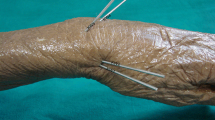Abstract
There has been little research comparing rates of infectious complications between buried and percutaneous Kirschner wire (K-wire) use in hand trauma surgery. The additional cost of removing buried wires should be justified by a demonstrable reduction in the frequency and/or severity of infectious complications. We prospectively collected data on infective complications associated with K-wire use during the course of 1 year at our hand trauma unit. We observed seven (10%) infections in 70 patients where wires were left protruding and three (9%) infections in 34 patients where wires were buried. There was no statistically significant difference in the rate of infectious complications. A cost analysis was performed, taking into account infectious complications and the cost of their management. Burying K-wires resulted in an extra cost of £235.51 per patient compared to £90.80 per patient for percutaneous K-wires. Thus, the use of buried K-wires results in a £144.71 increase in cost per patient. Clinicians should consider these findings, as well as other (medical) considerations, when making the decision whether to bury K-wires.
Similar content being viewed by others
References
Hargreaves DG, Drew SJ, Eckersley R (2004) Kirschner wire pin tract infection rates: a randomized controlled trial between percutaneous and buried wires. J Hand Surg [Eur] 29B:374–376
Rafique A, Ghani S, Sadiq M et al (2006) Kirschner wire pin tract infection rates between percutaneous and buried wires in treating metacarpal and phalangeal fractures. J Coll Physicians Surg Pak 16:518–520
Hsu LP, Schwartz EG, Kalainov DM et al (2011) Complications of K-wire fixation in procedures involving the hand and wrist. J Hand Surg 36A:610–616
Birdsall PD, Milne DD (1999) Toxic shock syndrome due to percutaneous Kirschner wires. Injury 30:509–510
Botte MJ, Davis JL, Rose BA et al (1992) Complications of smooth pin fixation of fractures and dislocations in the hand and wrist. Clin Orthop Relat Res 276:194–201
Stahl S, Schwartz O (2001) Complications of K-wire fixation and dislocations in the hand and wrist. Arch Orthop Trauma Surg 121:527–530
Faraj AA, Davis TR (1999) Percutaneous intramedullary fixation of metacarpal shaft fractures. J Hand Surg [Br] 24:76–79
Lakshmanan P, Dixit V, Reed MR et al (2010) Infection rate of percutaneous Kirschner wire fixation for distal radius fractures. J Orthop Surg 18:85–86
Moholkar K, Lodi Y, Corrigan J (2003) Implant removal on an outpatient basis. A patient satisfaction survey. Acta Orthop Belg 69:507–509
Conflict of interest
All named authors hereby declare that they have no conflicts of interest to disclose. This research received no specific grant from any funding agency in the public, commercial, or not-for-profit sectors. The local Research and Development department approved the study.
Author information
Authors and Affiliations
Corresponding author
Rights and permissions
About this article
Cite this article
Koç, T., Ahmed, J. & Aleksyeyenko, S. Buried Kirschner wires in hand trauma. Eur J Plast Surg 35, 803–807 (2012). https://doi.org/10.1007/s00238-012-0708-0
Received:
Accepted:
Published:
Issue Date:
DOI: https://doi.org/10.1007/s00238-012-0708-0




